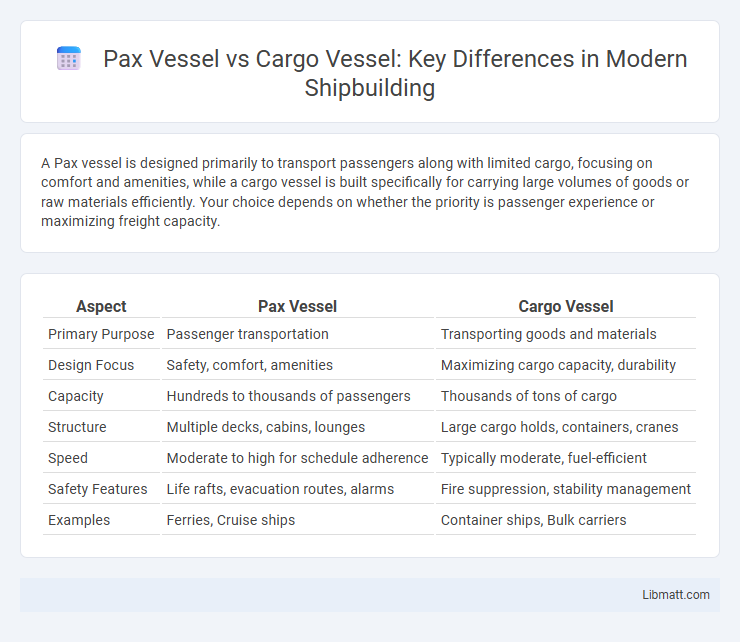A Pax vessel is designed primarily to transport passengers along with limited cargo, focusing on comfort and amenities, while a cargo vessel is built specifically for carrying large volumes of goods or raw materials efficiently. Your choice depends on whether the priority is passenger experience or maximizing freight capacity.
Table of Comparison
| Aspect | Pax Vessel | Cargo Vessel |
|---|---|---|
| Primary Purpose | Passenger transportation | Transporting goods and materials |
| Design Focus | Safety, comfort, amenities | Maximizing cargo capacity, durability |
| Capacity | Hundreds to thousands of passengers | Thousands of tons of cargo |
| Structure | Multiple decks, cabins, lounges | Large cargo holds, containers, cranes |
| Speed | Moderate to high for schedule adherence | Typically moderate, fuel-efficient |
| Safety Features | Life rafts, evacuation routes, alarms | Fire suppression, stability management |
| Examples | Ferries, Cruise ships | Container ships, Bulk carriers |
Introduction to Pax Vessels and Cargo Vessels
Pax vessels specialize in transporting passengers, offering amenities and safety features tailored for comfort during sea travel, while cargo vessels prioritize the efficient movement of goods with diverse designs such as container ships, bulk carriers, and tankers. The structural configuration of pax vessels supports cabins, lounges, and entertainment, contrasting sharply with the vast, open holds or container stacks of cargo ships optimized for maximizing freight capacity. Understanding these fundamental differences highlights the distinct operational roles and design priorities essential to maritime transportation.
Definition and Primary Functions
Pax vessels, designed primarily for passenger transport, emphasize comfort, safety, and onboard amenities, facilitating travel and tourism across seas. Cargo vessels focus on the efficient and secure movement of goods, with specialized structures such as container ships, tankers, or bulk carriers tailored to specific types of freight. The primary function of pax vessels is to ensure passenger convenience and safety, whereas cargo vessels optimize cargo capacity and handling efficiency.
Key Design Differences
Pax vessels prioritize passenger comfort and safety, featuring spacious cabins, extensive amenities, and multiple lifesaving equipment tailored to human occupancy. Cargo vessels focus on maximizing storage capacity and structural strength, with large open decks or specialized containers designed to transport goods efficiently. Your choice between these vessels depends on whether optimized passenger experience or freight handling capabilities is the primary operational goal.
Types of Pax Vessels
Passenger vessels include various types such as ferries, cruise ships, and luxury yachts, each designed to transport people rather than cargo. Ferries typically handle short-distance travel and provide vital connections for commuters and vehicles, while cruise ships offer extended voyages with extensive amenities focused on leisure. Your choice depends on travel needs, with ferries prioritizing efficiency and cruise ships emphasizing comfort and entertainment.
Types of Cargo Vessels
Cargo vessels include bulk carriers, container ships, tankers, and roll-on/roll-off (RoRo) ships, each designed to transport specific types of goods. Pax vessels, built primarily for passenger transport, differ fundamentally from cargo ships by prioritizing passenger amenities and safety rather than cargo capacity. Understanding the various cargo vessel types helps you optimize logistics for freight transport depending on the nature of the cargo.
Operational Roles and Routes
Pax vessels primarily serve passenger transportation with routes connecting major cities, tourist destinations, and short-sea crossings, emphasizing comfort and amenities. Cargo vessels focus on transporting goods across long-haul international trade routes, optimizing for capacity, fuel efficiency, and cargo handling. Your choice depends on whether the priority is passenger experience or freight logistics in maritime operations.
Capacity and Load Specifications
Pax vessels are designed primarily to transport passengers and their luggage, typically accommodating hundreds to thousands of individuals with a moderate cargo capacity limited to personal belongings and onboard supplies. Cargo vessels, on the other hand, focus on maximizing load capacity with specifications varying from a few thousand to over 200,000 deadweight tons (DWT), optimized for carrying bulk goods, containers, or specialized freight. Your choice between a pax vessel and a cargo vessel should consider the need for passenger accommodations versus the volume and type of cargo to be transported.
Safety Standards and Regulations
Pax vessels and cargo vessels both adhere to stringent international safety standards set by the International Maritime Organization (IMO), including SOLAS (Safety of Life at Sea) regulations. Passenger vessels face more rigorous requirements for lifesaving appliances, fire protection systems, and evacuation procedures due to the higher number of people onboard, while cargo vessels emphasize stability, safe stowage, and hazardous material handling. Compliance with these regulations ensures operational safety, minimizes risks, and protects crew, passengers, and cargo during maritime transport.
Environmental Impact Comparisons
Pax vessels generally have a higher environmental impact per passenger due to increased energy consumption for amenities and accommodations, whereas cargo vessels are more fuel-efficient relative to their tonnage but emit significant greenhouse gases due to heavy fuel oil use. Modern cargo vessels are increasingly adopting cleaner technologies like LNG and scrubbers to reduce sulfur emissions, while passenger vessels invest in advanced wastewater treatment and waste management systems to minimize marine pollution. Both vessel types face growing regulatory pressure under IMO guidelines to lower their carbon footprints and implement sustainable operational practices.
Future Trends in Maritime Transport
Future trends in maritime transport highlight increased automation and digitalization in both Pax vessels and cargo vessels, enhancing operational efficiency and safety. The adoption of green technologies, such as LNG and hydrogen fuels, is accelerating to reduce carbon emissions across passenger and cargo fleets. Smart port integration and real-time data analytics improve logistics coordination, driving innovation in vessel design and sustainable maritime infrastructure.
Pax vessel vs cargo vessel Infographic

 libmatt.com
libmatt.com